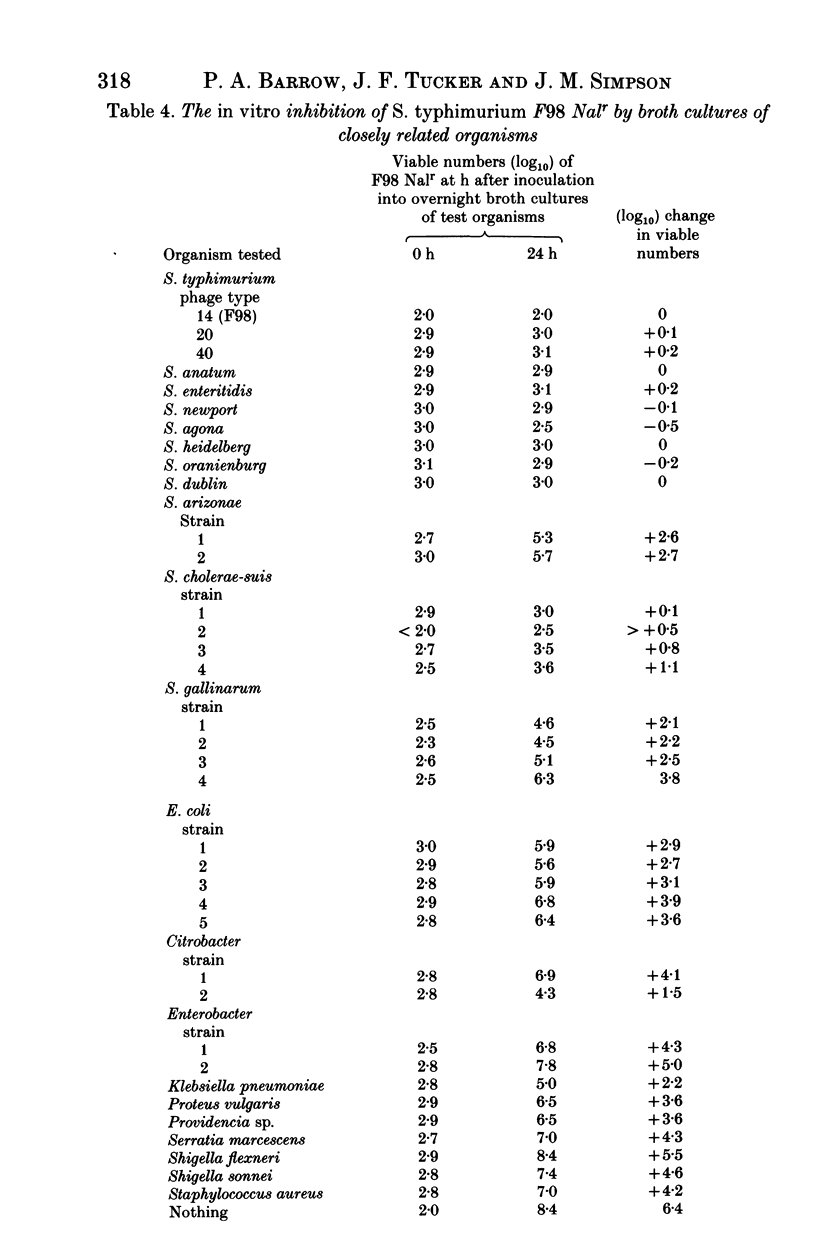Abstract
Oral administration of strains of food poisoning salmonellas to day-old chickens produced a profound inhibition in the subsequent colonization of the caeca by a strain of Salmonella typhimurium given one day later. Closely related genera were unable to produce a similar inhibition. The inhibition was not the result of bacteriophages produced by the first strain. Neither was it the result of an immunological response by the host induced by the first strain. In additional experiments in day-old chickens, inhibition of an Escherichia coli Nalr strain and of a Citrobacter sp. Nalr strain was produced by the antibiotic-sensitive forms of the homologous strains while strains from other genera did not produce any inhibition. When an avirulent mutant of S. typhimurium was used for pre-treatment a statistically significant reduction in the excretion of the super-infecting S. typhimurium Nalr strain over several weeks was produced. A genus specific inhibition was reproduced in vitro by mixed culture experiments. Live cultures were necessary for in vitro inhibition. Killed cells or a culture supernatant produced no inhibition.
Full text
PDF











Selected References
These references are in PubMed. This may not be the complete list of references from this article.
- Barnes E. M., Impey C. S., Cooper D. M. Manipulation of the crop and intestinal flora of the newly hatched chick. Am J Clin Nutr. 1980 Nov;33(11 Suppl):2426–2433. doi: 10.1093/ajcn/33.11.2426. [DOI] [PubMed] [Google Scholar]
- Barrow P. A., Tucker J. F. Inhibition of colonization of the chicken caecum with Salmonella typhimurium by pre-treatment with strains of Escherichia coli. J Hyg (Lond) 1986 Apr;96(2):161–169. doi: 10.1017/s0022172400065931. [DOI] [PMC free article] [PubMed] [Google Scholar]
- Coloe P. J., Bagust T. J., Ireland L. Development of the normal gastrointestinal microflora of specific pathogen-free chickens. J Hyg (Lond) 1984 Feb;92(1):79–87. doi: 10.1017/s0022172400064056. [DOI] [PMC free article] [PubMed] [Google Scholar]
- Dorn P., Krabisch P. Experimentelle Untersuchungen zur Salmonellen-Bekämpfung beim Mastküken durch Substitution der Darmflora. Dtsch Tierarztl Wochenschr. 1981 Feb 5;88(2):54–59. [PubMed] [Google Scholar]
- Impey C. S., Mead G. C., George S. M. Competitive exclusion of salmonellas from the chick caecum using a defined mixture of bacterial isolates from the caecal microflora of an adult bird. J Hyg (Lond) 1982 Dec;89(3):479–490. doi: 10.1017/s0022172400071047. [DOI] [PMC free article] [PubMed] [Google Scholar]
- Lloyd A. B., Cumming R. B., Kent R. D. Prevention of Salmonella typhimurium infection inpoultry by pretreatment of chickens and poults with intestinal extracts. Aust Vet J. 1977 Feb;53(2):82–87. doi: 10.1111/j.1751-0813.1977.tb14891.x. [DOI] [PubMed] [Google Scholar]
- Nurmi E., Rantala M. New aspects of Salmonella infection in broiler production. Nature. 1973 Jan 19;241(5386):210–211. doi: 10.1038/241210a0. [DOI] [PubMed] [Google Scholar]
- Rantala M. Cultivation of a bacterial flora able to prevent the colonization of Salmonella infantis in the intestines of broiler chickens, and its use. Acta Pathol Microbiol Scand B Microbiol Immunol. 1974 Feb;82(1):75–80. doi: 10.1111/j.1699-0463.1974.tb02295.x. [DOI] [PubMed] [Google Scholar]
- Rantala M., Nurmi E. Prevention of the growth of Salmonella infantis in chicks by the flora of the alimentary tract of chickens. Br Poult Sci. 1973 Nov;14(6):627–630. doi: 10.1080/00071667308416073. [DOI] [PubMed] [Google Scholar]
- Smith H. W. The development of the flora of the alimentary tract in young animals. J Pathol Bacteriol. 1965 Oct;90(2):495–513. [PubMed] [Google Scholar]
- Smith H. W., Tucker J. F. The effect of antibiotic therapy on the faecal excretion of Salmonella typhimurium by experimentally infected chickens. J Hyg (Lond) 1975 Oct;75(2):275–292. doi: 10.1017/s0022172400047306. [DOI] [PMC free article] [PubMed] [Google Scholar]
- Snoeyenbos G. H., Weinack O. M., Smyser C. F. Protecting chicks and poults from Salmonellae by oral administration of "normal" gut microflora. Avian Dis. 1978 Apr-Jun;22(2):273–287. [PubMed] [Google Scholar]
- Soerjadi A. S., Lloyd A. B., Cumming R. B. Streptococcus faecalis, a bacterial isolate which protects young chickens from enteric invasion by Salmonellae. Aust Vet J. 1978 Nov;54(11):549–550. doi: 10.1111/j.1751-0813.1978.tb00337.x. [DOI] [PubMed] [Google Scholar]
- Williams Smith H., Tucker J. F. The virulence of salmonella strains for chickens: their excretion by infected chickens. J Hyg (Lond) 1980 Jun;84(3):479–488. doi: 10.1017/s0022172400027017. [DOI] [PMC free article] [PubMed] [Google Scholar]


